
Challenge for students expressing two digit numbers using knowledge of place value.
- Subject:
- Mathematics
- Material Type:
- Activity/Lab
- Assessment
- Homework/Assignment
- Date Added:
- 04/20/2021

Challenge for students expressing two digit numbers using knowledge of place value.
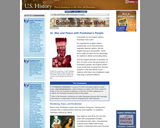
Despite his suspicions, Chief Powhatan helped the British settlers through their first winters. But the good relations did not last, and Powhatan was forced to fight.
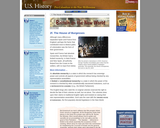
Although many differences separated Spain and France from England, perhaps the factor that contributed most to distinct paths of colonization was the form of their government.
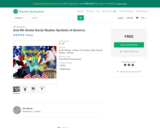
This is a PowerPoint presentation about the different symbols of America. This is for elementary school students to learn about the different symbols of America and what a symbol is. ...
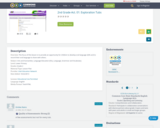
Overview: The focus of this lesson is to provide an opportunity for children to develop oral language skills and to record their oral language to share with others.
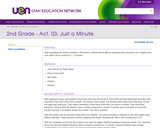
After completing the various activities in this lesson, students will be able to understand the importance for a healthy body to be able to do an activity for 1 - 5 minutes.
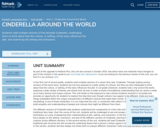
In this first unit of second grade, students read multiple versions of a classic fairy tale, Cinderella. Through reading various versions of the same story, students are not only exposed to a wide variety of cultures, but they are also challenged to think about how the culture, or setting, of the story influences the plot. In 1st grade Literature, students took a trip around the world, exploring a wide variety of themes and stories from all over in order to build a foundational understanding that our world is made up of many diverse and unique cultures. This unit builds on the exposure to new cultures students received in 1st grade and provides an opportunity for students to explore the idea that even though cultures may appear to be different, there are many things embedded within the unique characteristics of different cultures that make them similar. Storytelling, and the role of storytelling, is one of those similarities. It is our hope that this unit, in connection with others in the sequence, helps students build empathy and understanding of people and cultures that might be different from them.
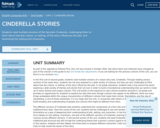
Overview: In this first unit of second grade, students read multiple versions of a classic fairy tale, Cinderella. Through reading various versions of the same story, students are not only exposed to a wide variety of cultures, but they are also challenged to think about how the culture, or setting, of the story influences the plot. In first grade fiction, students took a trip around the world, exploring a wide variety of themes and stories from all over, in order to build a foundational understanding that our world is made up of many diverse and unique cultures. This unit builds on the exposure to new cultures students received in first grade and provides an opportunity for students to explore the idea that even though cultures may appear to be different, there are many things embedded within the unique characteristics of different cultures that make them similar. Storytelling, and the role of storytelling, is one of those similarities. It is our hope that this unit, in connection with others in the sequence, helps students build empathy and understanding of the world around them.
The different versions of Cinderella help students understand the components of a fairy tale and the lessons associated with traditional fairy tales. Over the course of the unit, students will be challenged to ask and answer questions about the text and illustrations as a way of deepening their understanding of plot, setting, and characters. In the first section of the unit, students will focus deeply on the setting, characters, and plot of the different versions of Cinderella, learning to compare and contrast the nuances across different versions. In the second section of the unit, students will read Cinderella stories that vary from the traditional plot structure but still include the underlying theme that a person's actions (good or bad) influence his/her life outcomes. In this section students will dive deeply into three texts to analyze different characters' traits and how the author uses those traits to help reveal the lesson of the story.
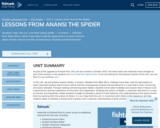
In this unit, second graders explore Spider, or Anansi, folktales from West Africa. Folktales have been used for generations to teach important lessons about human nature and the consequences of good and bad behavior in a way that is clear, convincing, and easily relatable. Through reading and learning about Spider, students will be able to debate and analyze what it means to be a good person and the importance of hard work and cooperation. Studying the actions of Spider, a character with whom it is easy to connect and empathize, allows students to begin to develop a sense of moral behavior and understanding of the world around them by learning from the actions of others. It is our hope that this unit, in connection with others in the sequence, will help students begin to develop a strong moral compass and a nuanced understanding of what constitutes right and wrong.
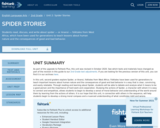
In this folktales unit, second graders explore Spider, or Anansi, folktales from Western Africa. Folktales have been used for generations to teach important lessons about human nature and the consequences of good and bad behavior in a way that is clear, convincing, and easily relatable. Through reading and learning about Spider, students will be able to debate and analyze what it means to be a good person and the importance of hard work and cooperation. Studying the actions of Spider, a character with whom it is easy to connect and empathize, allows students to begin to develop a sense of moral behavior and understanding of the world around them by learning from the actions of others. It is our hope that this unit, in connection with others in the sequence, will help students begin to develop a strong moral compass and understanding of what constitutes'right' and'wrong.'
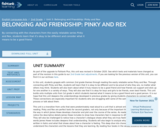
In this unit, students grapple with common 2nd grade themes through reading the easily relatable series Pinky and Rex. Through connecting with Pinky and Rex, students will learn that it is okay to be different and to be proud of who they are, no matter what others may think. Students will also learn about what it truly means to be a good friend and how friends can support and stick up for one another in a variety of ways. They will also see that it is okay for boys and girls to be friends, even best friends. This unit builds onto multiple units from 1st grade in which students learned what it means to be a good friend and a good person. It is our hope that this unit deepens the understandings developed in previous grades by giving students characters to connect with. These connections are especially important for students who are struggling with some of the same issues and are not sure how to process or talk about them.
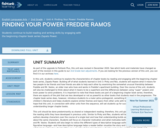
In this unit, students continue to explore the characteristics of chapter books by reading and engaging with the beginning chapter book series, Zapato Power. Building off of what students learned in Unit 3: Pinky and Rex, students will explore what it means for two people to be friends and how friends are able to help each other by examining the somewhat unusual friendship between Freddie and Mr. Vaslov, an older man who lives and works in Freddie’s apartment building. Over the course of the unit, students will also be challenged to think about what it means to be a superhero and the differences between using “super” powers and brain power to solve problems. It is important to note that these books are part of a beginning chapter book series; therefore, there are aspects of the plot that are less developed or not as powerful as other books that students read in the progression. The chapter book series does, however, introduce students to a male Latinx protagonist, something that is often missing from children’s literature and helps students explore similar themes and topics from other units with texts that are accessible. It is our hope that this unit, in connection with other units from the sequence, will set students up for success in reading and understanding longer chapter books.
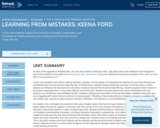
In this unit, students learn about making mistakes, honesty, and the power of forgiveness by reading the core texts Freckle Juice and Keena Ford and the Second-Grade Mix-Up. In Freckle Juice, students explore what peer pressure is and the ways in which people can influence the decisions that we make. In Keena Ford and the Second-Grade Mix-Up, students explore what it means to be honest, especially when it may seem difficult to tell the truth. Students will also explore the value of friendship and how jealousy can sometimes come between friends. Andrew in Freckle Juice and Keena Ford are both highly relatable characters who are struggling with issues that are common in second grade. Therefore, these books will give students a chance to grapple with and explore the nuances of peer pressure, honesty, friendship, and jealousy in a non-threatening way.
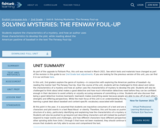
In this unit, 2nd graders explore the genre of mystery—in conjunction with exploring the American pastime of baseball—by reading the mentor text The Fenway Foul-Up. Over the course of the unit, students will be challenged to think about and notice the characteristics of a mystery and how an author uses the characteristics of mystery to develop the plot. Students will also be challenged to think about what makes a good detective and how much information detectives need before they can be confident enough in their decisions to avoid unfairly or unjustly accusing someone of committing a crime. Students will also discover that being a good detective involves teamwork; teamwork makes everything easier because people are able to play off of each other’s strengths and differing perspectives. While the main focus of this unit is on understanding the mystery genre, students will also be learning a great deal about baseball and content-specific vocabulary associated with baseball.
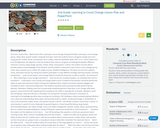
Lesson Plan – Math Lesson Plan: Learning to Count Change 2nd grade Activity: Learning to count change: penny, nickel, dime, quarter Grade: 2nd grade Concepts: Teach the students how to recognize change and count using pennies, nickels, dimes, and quarters up to a dollar. National Standards: Math- MA 2.2.5.a. Count mixed coins to $1.00 Objectives: the objective is that the students learn how to recognize and distinguish between different American currency using change: pennies, nickels, dimes, and quarters. Criteria: The student must be able to provide evidence and knowledge of the behavior and the student is expected to learn how to count change (penny, nickel, dime, quarter) up to a dollar will a high accuracy. Multiple Intelligences: The lesson accounts for auditory, visual, and kinetic learners by having the students participate in many different strategic learning activities. Essential Question(s):1. How can learning to count change help you inside the classroom as well as outside the classroom?2. Why is learning to count change important?3. How can we use counting change in our everyday lives? Ask for examples.4. Is learning to count money and change useful to you? Conditions:The behavior should be performed within as open class discussion before moving into individual work. Students should be relaxed, engaged, and motivated to learn. Instructional Objectives: The students should be active participants while performing the behavior. Motivation: Making math fun! Incorporating something special to help them count change. Jelly beans, popcorn, (some kind of treat). Explaining how counting can be useful in everyday life. Examples: allowance, tooth fairy, birthdays). They each will earn a chocolate coin during their formative assessment. Connection to Learning:Prior knowledge would be skip-counting and counting to 100. Building on skip-counting by giving individual coins value and understanding those values and how they build to a dollar. Vocabulary:Change: a combination of coins such as pennies, nickels, dimes, and quarters.Penny: is worth 1 cent.Nickel: is worth 5 cents.Dime: is worth 10 cents.Quarter: is worth 25 cents. Materials:ComputerProjector or Smart boardThe Money Song, by Jack HartmannWorksheets: Let’s Make Change, Coins! Let’s Make ChangeCoins: pennies, nickels, dimes, quartersActivity: Race to a Dollar! And paperclipReward: Candy (of whatever reward you would like to use) Procedures:1. Introduce the subject and the objective to the class.2. Start off by asking a few questions a short pre-assessment about counting money. What previous knowledge does the class know?3. Explain the video we are going to watch that helps introduce the less. Explain how it teaches the students about money: pennies, nickels, dimes, and quarters. Let them know we are going to learn a song about money to help them remember the important facts.4. Watch the video once5. Teach the students about the song. Work on the song together as a class.6. Let the class know we are going to play a little game about making change after the video.7. Watch the video a second time and have the students sing along.8. Introduce the class activity: Race to a Dollar game9. Explain the rules to the game and how the winner gets a reward. (You can play the game anyway you would like).10. Once the game is over and the teacher feels comfortable that the class understood the lesson, pass out and explain the directions for the first or second worksheet.11. Explain the instruction and dismiss the class to work independently. This is a great time to walk about and formally assess the students independently.12. Hand out the second worksheet for homework.13. Explain that we will continue to build on this lesson in the days to follow.14. A summative assessment will be given at the end of the week. Assessment:Formative assessment - Worksheet: Coins! Let’s Make Change. The teacher will walk around and ask every student individually a questions about change in order to “buy” a chocolate wrapped quarter. Ex: In order to “buy” this candy from me how can you use different coins to make 30 cents. The student answers: 3 dimes. The teacher will help each student through the question and assess their current knowledge.Summative assessment - quiz on the lesson, how to count change focusing on (pennies, nickels, dimes, and quarters.) Accommodations/Accommodations for special needs child:Teacher will allow for one on one instruction time once the class has been dismissed to work independently. The class activity will be accomplished with a partner that and or the students will partner up with a student and they will become a team during this activity. The formative assessment will stay the same and the summative assessment will have each student's individual needs and or accommodations as stated in their IEP. Accommodations for ESL/ELL child: If necessary the teacher will have all directions and instructions written in the students dominate language as well as English to help them understand and accomplish the lesson. Resources:State Standards: https://www.perma-bound.com/state-standards.do?state=NE&subject=mathematics&gradeLevel=2https://www.perma-bound.com/state-standards.do?state=NE&subject=arts-education&gradeLevel=KYouTube: The Money Song: https://www.youtube.com/watch?v=pnXJGNo08v0Pinterest: https://www.pinterest.com/search/pins/?q=making%20change%20worksheets&rs=rs&eq=&etslf=3110&term_meta[]=making%7Crecentsearch%7Cundefined&term_meta[]=change%7Crecentsearch%7Cundefined&term_meta[]=worksheets%7Crecentsearch%7Cundefinedhttps://www.pinterest.com/pin/287597126182911466/ The Money Song | Penny, Nickel, Dime, QuarterBy, Jack Hartmann Penny, nickel, dime, quarter…Lets learnPenny, nickel, dime, quarter…Lets learn Money, money, money in my pocketMoney, money, I know how to count itMoney, money, money in my pocketMoney, money, I know how to count it What’s it worth? How much is a penny? 1 centHow much is a nickel? 5 centsHow much is a dime? 10 centsHow much is a quarter? 25 cents How much is a penny? 1 centHow much is a nickel? 5 centsHow much is a dime? 10 centsHow much is a quarter? 25 cents Money, money, money in my pocketMoney, money, I know how to count itMoney, money, money in my pocketMoney, money, I know how to count it What’s it worth? How much is a penny? 1 centHow much is a nickel? 5 centsHow much is a dime? 10 centsHow much is a quarter? 25 cents How much is a penny? 1 centHow much is a nickel? 5 centsHow much is a dime? 10 centsHow much is a quarter? 25 cents Money, money, money in my pocketMoney, money, I know how to count itMoney, money, money in my pocketMoney, money, I know how to count it Here is a penny and this is what it looks like…Penny, penny,A penny is worth? 1 centA penny is worth? 1 cent Here is a nickel and this is what it looks like…Nickel, nickelA nickel is worth? 5 centsA nickel is worth? 5 cents Here is a dime and this is what it looks like…Dime, dimeA dime is worth? 10 centsA dime is worth? 10 Cents Here is a quarter and this is what it looks like…Quarter, quarterA quarter is worth? 25 centsA quarter is worth? 25 cents Money, money, money in my pocketMoney, money, I know how to count itMoney, money, money in my pocketMoney, money, I know how to count it Money, money, money in my pocketMoney, money, I know how to count itMoney, money, money in my pocketMoney, money, I know how to count it Money, money, money in my pocketMoney, money, I know how to count itMoney, money, money in my pocketMoney, money, I know how to count it Money, money, money in my pocketMoney, money, I know how to count itMoney, money, money in my pocketMoney, money, I know how to count it

This lesson covers the concept of skip counting by 5's and 10's.

This graphic organizer helps students compare an Osage Indian Family, a Pioneer Family, and a Modern Family. There are places to write about their homes, clothing, food, travel, and to draw an illustration. It is meant to be printed on legal paper.
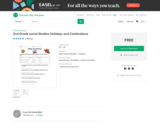
Match the holiday name to the definition for Kwaanza, Independence Day, Martin Luther King Jr. Day, President's Day, Chinese New Year, Thanksgiving, Columbus Day, Labor Day, and Veterans Day. Social studies activity best for second and third grade.
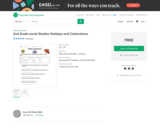
Match the holiday name to the definition for Kwaanza, Independence Day, Martin Luther King Jr. Day, President's Day, Chinese New Year, Thanksgiving, Columbus Day, Labor Day, and Veterans Day. Social studies activity best for second and third grade. Ten questions total with an open response question ...
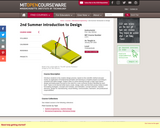
Introduce students to the creative design process, based on the scientific method and peer review, by application of fundamental principles and learning to complete projects according to schedule and within budget. Subject relies on active learning through a major team-based design-and-build project focused on the need for a new consumer product identified by each team. Topics to be learned while teams create, design, build, and test their product ideas include formulating strategies, concepts and modules, and estimation, concept selection, machine elements, design for manufacturing, visual thinking, communication, teamwork, and professional responsibilities.